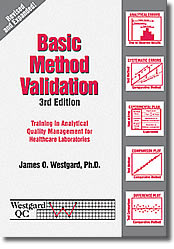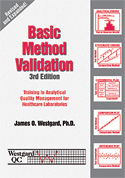Basic Method Validation
The Linearity or Reportable Range Experiment
Elsa Quam BS, MT(ASCP) -- a frequent contributor to our Basic QC series -- turns in this essay for our Method Validation series. It is crucial to know the upper and lower limits of a test's reportable range. Elsa gives a step-by-step explanation of how to prepare and calculate the experiment that determines the range, using a cholesterol example as well as two Javascript worksheet calculators. Once you're done reading, you can plug in your own data and see the results. (Preview)
|
|
| Note: This lesson is drawn from the first edition of the Basic Method Validation book. This reference manual is now in its third edition. The updated version of this material is also available in an online training program accredited by both the AACC and ASCLS. |
Purpose
It is important to assess the useful analytical range of a laboratory method, i.e., the lowest and highest test results that are reliable and can be reported. Manufacturers make claims for the reportable range of their methods by the stating the upper and lower limits of the range. It is generally assumed that the analytical method produces a linear response and that the test results between those upper and lower limits are then reportable. CLIA recommends that laboratories verify the reportable range of all moderate and high complexity tests [1].
Factors to consider
CLIA does not strictly require that a method provide a linear response, but laboratories commonly use a "linearity" type of experiment to check the reportable range for a test. In this experiment, a laboratory will analyze a series of samples with known concentrations, or a series of diluted samples. The measured results are plotted on the y-axis vs the expected or known values on the x-axis. The reportable range is then assessed by drawing the best straight line through the linear portion of the data. That line may be drawn manually by making a "visual fit", or by computer using the "best fit" from linear regression statistics. The statistical analysis could become fairly complicated to assess linearity, but it is commonly accepted that the reportable range can be adequately determined from "eyeballing" the data and manually drawing the best straight line that fits the lowest points in the series.
Number of levels
The National Committee for Clinical Laboratory Standards (NCCLS) recommends a minimum of at least 4 - and preferably 5 - different levels or concentrations [2]. More than 5 can be used, but we have found that 5 levels are convenient and almost always sufficient.
Materials
Standard solutions may be easy to prepare for some tests. For others, manufacturers and proficiency testing agencies may supply linearity sets having known values or known relationships between materials. Dilutions of patient specimens, or pools of patient specmens, may also be used and are often convenient and economical when high values are available. In some cases, e.g., TDMs, it may be necessary to spike a pool with the analyte to be measured in order to get the desired high level.
We invite you to read the rest of this article.
This article, plus many more important, updated, and expanded chapters are available in the Basic Method Validation manual, 3rd Edition which is available at our online store. You can download the Table of Contents and other chapters here. You can also enroll in the Basic Method Validation course and access the new materials online.


